|
Neric-Club.Com
|
|
|
 |
|
นิตยสารออนไลน์
|
|
|
 |
|
มุมเบ็ดเตล็ด
|
|
|
 |
|
|
|
|
 |
อังกฤษท่องเที่ยว |
 |
|
Phitsanulok Province
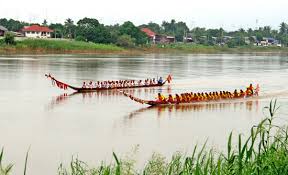
Caravan trail of boats, Nan River, Phitsanulok |
- Located between the Northern and Central Regions of Thailand, Phitsanulok has two important rivers, Nan and Yom. Many cultural and traditional activities of the people in the province has direct influence from the lifestyle that has always been associated with water.
|
Phitsanulok is 377 kms. by road from Bangkok. It is one of the most interesting provinces in the North, serving as a center for commerce, transportation and communication. It is situated on the geographical and administrational line that devides the Central region from the Northern region.
Phitsanulok is the birthplace of King Naresuan the Great and his equally brave and able brother, Prince Ekatosarot. As the cross-road between the Northern and Central regions of the country, Phitsanulok has long been an important center both for political and strategical reason. It was a recruiting place when Ayutthaya had war with Myanmar. It was a training ground for many kings of Ayutthaya And it was a capital of Thailand for 25 years during the reign of King Boromtrailokkanat of Ayutthaya.
The climate of Phitsanulok is generally hot and humid. It borders with Uttaradit in the North, Pichit in the South, Loei and Phetchabun in the East, Kamphaeng Phet and Sukhothai in the West. Covering an area of 10,815.8 square kilometers, the province is divided into 9 Amphoes: Muang, Bang Krathum, Bang Rakam, Chat Trakan, Nakhon Thai, Noen Maprang, Phrom Phiram, Wang Thong and Wat Bot.
TOURIST ATTRACTION
|
Wat Phra Si Rattana Mahathat
Wat Phra Si Rattana Mahathat (part 2)
Wat Phra Si Rattana Mahathat (pictures)
Thung Salaeng Luang National Park
Chat Trakan Naitonal Park |
Wat Ratchaburana
Museum of Folk Craft
Wat Nang Phraya
Phu Hin Rongkla National Park
Phitsanulok Boat Races.
|
TANAPAT TOUR
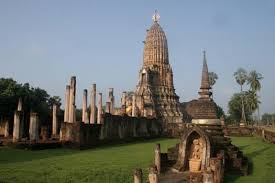
Wat Phra Si Rattana Mahathat |
Wat Phra Si Rattana Mahathat
This monastery commonly called by the inhabitants as "Wat Yai", is the most important monastery of Phitsanulok, the home of the famous Phra Buddha Chinnarat. It is located at the foot of Naresuan Bridge on the city side of the river.
|
The monastery was built in the reign of Phra Maha Thamma Racha I (Phraya Lithai) in 1357 A.D. It houses the Phra Buddha Chinnarat regarded as the most beautiful Buddha image in Thailand. It is cast in the attitude of subduing evil. Later, in 1631, King Ekatosarot graciously bestowed some of his gold regalia to be beaten into gold-plate and applied them to the image with his own hands, creating this most beautiful Buddha image.
There are the many other beautiful and noteworthy items in the monastery compound. The mother-of-pearl inlaid wooden doors of Vihara are especially splendid, and were built by King Boromkot in 1756 as a dedication to Phra Buddha Chinnarat. Behind the Vihara, there is a large prang 36 meters high, with a staircase leading up to the niche containing the Buddha relics. In front of the prang, there is Phra Attharos, and on the 9-Room Vihara slope, there remains only the newly-renovated Buddha image.

Dr. Tawee at his Museum of Folk Craft 
The fish trap tools showroom
|
Show beautiful pictures of Wat Phra Si Rattana Mahathat
 Sergeant-Major Dr. Tawee-Pim Buranaket, Museum of Folk Craft
Located opposite the Buranathai Buddha Image foundry, Wisutkasat road, Amphoe Muang. This museum is well known for its collections of all folk-arts, crafts, basketry, pottery and ancient kitchen utensils. In addition to these, there also are instruments for agriculture occupation and household living displayed.
Museum of Folk Craft in Phitsanulok and the aforementioned device, one of the displays at the museum, was in days gone by, employed by monks in temples for catching temple boys going out for a night on the town. These boys, while not ordained as monks or novices, are expected to stay within the compound of the temple after curfew. So while the trap did not actually 'catch' its victim, it would leve behind telltale marks. The next morning on almsround, the monk could ascertain who had disobeyed orders by simply observing who had a bruised shin or was limping.
This little contraption was one of many hundreds of objects on displays at this unique museum. The museum is obviously a labour of love for Dr. Tawee who was has amassed this astounding collection of traditional Thai household items: utensils of very kind, farming and hunting equipment, musical instruments, even textiles from this region and beyond. "I felt that it was important to collect many of these folk items now. The only people who still know how to use some of them are really old and after they are gone, the methods will be lost forever." In the museum we saw ingenious traps for catching all kinds of animals including snkes, birds, tigers, even porcupines. Sergeant-Major Dr. Tawee-Pim Buranaket, Museum of Folk Craft
Located opposite the Buranathai Buddha Image foundry, Wisutkasat road, Amphoe Muang. This museum is well known for its collections of all folk-arts, crafts, basketry, pottery and ancient kitchen utensils. In addition to these, there also are instruments for agriculture occupation and household living displayed.
Museum of Folk Craft in Phitsanulok and the aforementioned device, one of the displays at the museum, was in days gone by, employed by monks in temples for catching temple boys going out for a night on the town. These boys, while not ordained as monks or novices, are expected to stay within the compound of the temple after curfew. So while the trap did not actually 'catch' its victim, it would leve behind telltale marks. The next morning on almsround, the monk could ascertain who had disobeyed orders by simply observing who had a bruised shin or was limping.
This little contraption was one of many hundreds of objects on displays at this unique museum. The museum is obviously a labour of love for Dr. Tawee who was has amassed this astounding collection of traditional Thai household items: utensils of very kind, farming and hunting equipment, musical instruments, even textiles from this region and beyond. "I felt that it was important to collect many of these folk items now. The only people who still know how to use some of them are really old and after they are gone, the methods will be lost forever." In the museum we saw ingenious traps for catching all kinds of animals including snkes, birds, tigers, even porcupines.
|
While officially not yet open, the place is definitely worth seeking out, especially because next door is Dr. Tawee's workshop which casts Buddha images. Visitors are welcomed at any time and a guide will take you through, carefully explaining the various steps involved in making a Buddha statue. All of this plus a call on the museum at no cost whatsoever. undefined undefined
In the center of below picture called Chanyai, the fish trap tool, Material : Bamboo, rattan. Chanyai is a trap in the waterways with the door is turned to the tide. Leaves or branchs are stuck in order, called "Hu-Chang" when the fish enter Chanyai, they will bumb the rattan. Then, a cross stake and long spur wull be untied the door will be suddenly shut because of the stone which hung up with the door. undefined undefined
Museum hours are from 8.30 a.m. to 4.30 p.m. every day, closing monday. Location : 26/43 Sgt.Maj. Thawee-Folk Museum, Wisutkasat road, Amphoe Muang, Phitsanulok 65000. Telephone : (055) 258715, 212749.
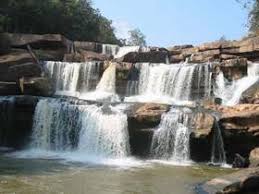 Thung Salaeng Luang National Park
Thung Salaeng Luang National Park is one of Thailand's major large-forest areas with a total area of 789,000 rais (315,600 acres) in two provinces, Phitsanulok and Phetchabun. It is located in Tambon Chomphu and Ban Thung of Amphoe Wang Thong, and in Tambon Nam Chun of Amphoe Lomsak. The park office is located at Km. 80 on Phitsanulok-Lomsak Highway, along which one can see beautiful lush green forests, high mountains with scenic winding roads. Main attraction in the park is 'Namtok Kaeng Sopha',at Km.71-72, regarded the most beautiful one in the area. For accommodation, contact the National Park Division, Division, Forestry Department, Tel.579-0529, 579-4842. Thung Salaeng Luang National Park
Thung Salaeng Luang National Park is one of Thailand's major large-forest areas with a total area of 789,000 rais (315,600 acres) in two provinces, Phitsanulok and Phetchabun. It is located in Tambon Chomphu and Ban Thung of Amphoe Wang Thong, and in Tambon Nam Chun of Amphoe Lomsak. The park office is located at Km. 80 on Phitsanulok-Lomsak Highway, along which one can see beautiful lush green forests, high mountains with scenic winding roads. Main attraction in the park is 'Namtok Kaeng Sopha',at Km.71-72, regarded the most beautiful one in the area. For accommodation, contact the National Park Division, Division, Forestry Department, Tel.579-0529, 579-4842.
 Chat Trakan Naitonal Park
It is located in Khao Ya Puk occupying a total area of 339,375 rais (135,750 acres) where a 7-levelled medium sized waterfall is the source of the Kwae Noi rivulet. To reach the Park, proceed along Phitsanulok-Lomsak Highway to Km. 67-68. Take Highway No. 2013 for a further distance to 29 kms. turn left, continuing 38 kms. to Amphoe Chat Trakan and turn right to Highway No.1237 for another 10 kms., a total distance of 145 kms. For accommodations, contact the National Park Division, Forestry Department, Tel 579-0529, 579-4842. Chat Trakan Naitonal Park
It is located in Khao Ya Puk occupying a total area of 339,375 rais (135,750 acres) where a 7-levelled medium sized waterfall is the source of the Kwae Noi rivulet. To reach the Park, proceed along Phitsanulok-Lomsak Highway to Km. 67-68. Take Highway No. 2013 for a further distance to 29 kms. turn left, continuing 38 kms. to Amphoe Chat Trakan and turn right to Highway No.1237 for another 10 kms., a total distance of 145 kms. For accommodations, contact the National Park Division, Forestry Department, Tel 579-0529, 579-4842.
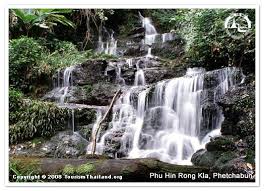 Phu Hin Rongkla National Park
This national park covers the total area of 191,875 rais (76,750 acres) and is about 123 kms. from Phitsanulok provincial city. To reach the park is by taking highway No. 12 (Phitsanulok-Lom Sak), at about Km.68 turn left at Ban Yaeng for a further distance of 24 kms. then turn right along the elevated road another 31 kms. The park area mainly covers with evergreen forest with beautiful waterfalls and a vast plain of rock with cracks scattered all around. Further-more the place used to be a bloody battle field due to the conflict in political idealism. Scars of fighting still can be seen from place to place. Tourists or visitors who want to stay over night are advised to make a prior reservation through the National Park Division, Forestry Department by Tel: 5794842, 5790529. Phu Hin Rongkla National Park
This national park covers the total area of 191,875 rais (76,750 acres) and is about 123 kms. from Phitsanulok provincial city. To reach the park is by taking highway No. 12 (Phitsanulok-Lom Sak), at about Km.68 turn left at Ban Yaeng for a further distance of 24 kms. then turn right along the elevated road another 31 kms. The park area mainly covers with evergreen forest with beautiful waterfalls and a vast plain of rock with cracks scattered all around. Further-more the place used to be a bloody battle field due to the conflict in political idealism. Scars of fighting still can be seen from place to place. Tourists or visitors who want to stay over night are advised to make a prior reservation through the National Park Division, Forestry Department by Tel: 5794842, 5790529.
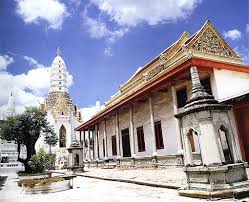 Wat Nang Phraya
This monastery is located on the eastern bank of the Nan River, near Wat Phra Si Ratana Mahathat to the south. This monasteries, assumed to be built when Phitsanulok City was ruled by somdet Phraboromtrai Lokkanat, have linking compounds. Wat Nang Phraya has no temple or bot but it is known for the so-called "Phrara Nang Phya" votive tablets found within the pagoda's repository. The vihara of Wat Nang Phya shares a special fine form of the 3-head nagas decorated on their eaves. Wat Nang Phraya
This monastery is located on the eastern bank of the Nan River, near Wat Phra Si Ratana Mahathat to the south. This monasteries, assumed to be built when Phitsanulok City was ruled by somdet Phraboromtrai Lokkanat, have linking compounds. Wat Nang Phraya has no temple or bot but it is known for the so-called "Phrara Nang Phya" votive tablets found within the pagoda's repository. The vihara of Wat Nang Phya shares a special fine form of the 3-head nagas decorated on their eaves.
September 19-20, 1988, Phitsanulok Boat Races, the provincial capital of Phitsanulok will hold its own boat races. Boat decoration and team cheering competitions are also part of the fun.
Long ago, this festival was founded to unite the community as well as to prepare themselves with boat techniques in case of war. Phitsanulok people in each village would join together to build and decorate their long-boats to complete in both speed and beauty. Nowadays, it is the biggest and most beautiful event of the province that attracts people from everywhere.
The sides of the boats are decorated according to each team's own unique style. After the best entry has been annanced, these beautiful boats are usually put on display at each village's temple as public property.
The energetic sounds of Thai instruments like Pee Pat, Khong, Thapoan, and Ching Chab, and the announcer call forattention before the race starts. When every boat is ready, the signal sparks the long awaited excitement. Each stroke of each person in each boat is in sync with the shouting they make to further accelerate themselves. The audience is hardly less noisy or excited each time the paddle digs the water. Then the greatest moment arrives with exploding, cheerful noises that cover the whole area with joy when the fastest boat finishes the glorious race.
The monastery was built in the reign of Phra Maha Thamma Racha I (Phraya Lithai) in 1357 A.D. It houses the Phra Buddha Chinnarat regarded as the most beautiful Buddha image in Thailand. It is cast in the attitude of subduing evil. Later, in 1631, King Ekatosarot graciously bestowed some of his gold regalia to be beaten into gold-plate and applied them to the image with his own hands, creating this most beautiful Buddha image.
There are the many other beautiful and noteworthy items in the monastery compound. The mother-of-pearl inlaid wooden doors of Vihara are especially splendid, and were built by King Boromkot in 1756 as a dedication to Phra Buddha Chinnarat. Behind the Vihara, there is a large prang 36 meters high, with a staircase leading up to the niche containing the Buddha relics. In front of the prang, there is Phra Attharos, and on the 9-Room Vihara slope, there remains only the newly-renovated Buddha image.
|
Show beautiful pictures of Wat Phra Si Rattana Mahathat
Sergeant-Major Dr. Tawee-Pim Buranaket, Museum of Folk Craft
Located opposite the Buranathai Buddha Image foundry, Wisutkasat road, Amphoe Muang. This museum is well known for its collections of all folk-arts, crafts, basketry, pottery and ancient kitchen utensils. In addition to these, there also are instruments for agriculture occupation and household living displayed.
Museum of Folk Craft in Phitsanulok and the aforementioned device, one of the displays at the museum, was in days gone by, employed by monks in temples for catching temple boys going out for a night on the town. These boys, while not ordained as monks or novices, are expected to stay within the compound of the temple after curfew. So while the trap did not actually 'catch' its victim, it would leve behind telltale marks. The next morning on almsround, the monk could ascertain who had disobeyed orders by simply observing who had a bruised shin or was limping.
This little contraption was one of many hundreds of objects on displays at this unique museum. The museum is obviously a labour of love for Dr. Tawee who was has amassed this astounding collection of traditional Thai household items: utensils of very kind, farming and hunting equipment, musical instruments, even textiles from this region and beyond. "I felt that it was important to collect many of these folk items now. The only people who still know how to use some of them are really old and after they are gone, the methods will be lost forever." In the museum we saw ingenious traps for catching all kinds of animals including snkes, birds, tigers, even porcupines.
|
While officially not yet open, the place is definitely worth seeking out, especially because next door is Dr. Tawee's workshop which casts Buddha images. Visitors are welcomed at any time and a guide will take you through, carefully explaining the various steps involved in making a Buddha statue. All of this plus a call on the museum at no cost whatsoever. undefined undefined
In the center of below picture called Chanyai, the fish trap tool, Material : Bamboo, rattan. Chanyai is a trap in the waterways with the door is turned to the tide. Leaves or branchs are stuck in order, called "Hu-Chang" when the fish enter Chanyai, they will bumb the rattan. Then, a cross stake and long spur wull be untied the door will be suddenly shut because of the stone which hung up with the door. undefined undefined
Museum hours are from 8.30 a.m. to 4.30 p.m. every day, closing monday. Location : 26/43 Sgt.Maj. Thawee-Folk Museum, Wisutkasat road, Amphoe Muang, Phitsanulok 65000. Telephone : (055) 258715, 212749.
Thung Salaeng Luang National Park
Thung Salaeng Luang National Park is one of Thailand's major large-forest areas with a total area of 789,000 rais (315,600 acres) in two provinces, Phitsanulok and Phetchabun. It is located in Tambon Chomphu and Ban Thung of Amphoe Wang Thong, and in Tambon Nam Chun of Amphoe Lomsak. The park office is located at Km. 80 on Phitsanulok-Lomsak Highway, along which one can see beautiful lush green forests, high mountains with scenic winding roads. Main attraction in the park is 'Namtok Kaeng Sopha',at Km.71-72, regarded the most beautiful one in the area. For accommodation, contact the National Park Division, Division, Forestry Department, Tel.579-0529, 579-4842.
Chat Trakan Naitonal Park
It is located in Khao Ya Puk occupying a total area of 339,375 rais (135,750 acres) where a 7-levelled medium sized waterfall is the source of the Kwae Noi rivulet. To reach the Park, proceed along Phitsanulok-Lomsak Highway to Km. 67-68. Take Highway No. 2013 for a further distance to 29 kms. turn left, continuing 38 kms. to Amphoe Chat Trakan and turn right to Highway No.1237 for another 10 kms., a total distance of 145 kms. For accommodations, contact the National Park Division, Forestry Department, Tel 579-0529, 579-4842.
Phu Hin Rongkla National Park
This national park covers the total area of 191,875 rais (76,750 acres) and is about 123 kms. from Phitsanulok provincial city. To reach the park is by taking highway No. 12 (Phitsanulok-Lom Sak), at about Km.68 turn left at Ban Yaeng for a further distance of 24 kms. then turn right along the elevated road another 31 kms. The park area mainly covers with evergreen forest with beautiful waterfalls and a vast plain of rock with cracks scattered all around. Further-more the place used to be a bloody battle field due to the conflict in political idealism. Scars of fighting still can be seen from place to place. Tourists or visitors who want to stay over night are advised to make a prior reservation through the National Park Division, Forestry Department by Tel: 5794842, 5790529.
Wat Nang Phraya
This monastery is located on the eastern bank of the Nan River, near Wat Phra Si Ratana Mahathat to the south. This monasteries, assumed to be built when Phitsanulok City was ruled by somdet Phraboromtrai Lokkanat, have linking compounds. Wat Nang Phraya has no temple or bot but it is known for the so-called "Phrara Nang Phya" votive tablets found within the pagoda's repository. The vihara of Wat Nang Phya shares a special fine form of the 3-head nagas decorated on their eaves.
September 19-20, 1988, Phitsanulok Boat Races, the provincial capital of Phitsanulok will hold its own boat races. Boat decoration and team cheering competitions are also part of the fun.
Long ago, this festival was founded to unite the community as well as to prepare themselves with boat techniques in case of war. Phitsanulok people in each village would join together to build and decorate their long-boats to complete in both speed and beauty. Nowadays, it is the biggest and most beautiful event of the province that attracts people from everywhere.
The sides of the boats are decorated according to each team's own unique style. After the best entry has been annanced, these beautiful boats are usually put on display at each village's temple as public property.
The energetic sounds of Thai instruments like Pee Pat, Khong, Thapoan, and Ching Chab, and the announcer call forattention before the race starts. When every boat is ready, the signal sparks the long awaited excitement. Each stroke of each person in each boat is in sync with the shouting they make to further accelerate themselves. The audience is hardly less noisy or excited each time the paddle digs the water. Then the greatest moment arrives with exploding, cheerful noises that cover the whole area with joy when the fastest boat finishes the glorious race.
|
|
|